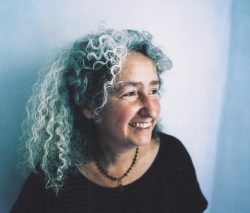Brooklyn Background Helps Nora Guthrie Keep Her Father’s Legacy Alive
Woody Guthrie once said, “All you can write is what you see.” Now folks can experience what the folk music legend wrote about with the new walking guide, “My Name Is New York: Ramblin’ Around Woody Guthrie’s Town”. The guide is the latest brainchild of Nora Guthrie, musician, artist and keeper of the flame of her father’s legacy. Guthrie told Brooklyn Roads that her upbringing made her feel “that I could do just about anything I wanted to in the arts”.
Throughout her childhood, she and her siblings (including big brothers Arlo and Joady) were exposed to just about every existing art form. “Some we took to more than others, but we were taught to at the very least ‘know’ what all the art forms were about. Over the years, I’ve done some of these professionally–dancing, clothing design, songwriting, record producing, concert producing, book editing, book designing,” Guthrie said. “Nowadays, it also helps me work comfortably with artists in each of these genres.”
Guthrie’s Coney Island upbringing exposed her to “just about every nationality, race, religion, and sex–right there on the beach and on the streets. So, I was always comfortable with just about everybody,” she said.
The now-shuttered Woodward School in Clinton Hill also helped shaped Guthrie’s artistic mind. “The teachers there were so creative and stressed creativity and, again, a sense of inclusion when it came to race, nationality, etc.” The music teacher–an old friend of Woody Guthrie– “taught us all the meaningful songs that are part of American folk music history, the racial equality movement and the labor movement.” Not surprisingly, “This Land Is Your Land” was a staple at the school, she said.
Marjorie Mazia Guthrie, Nora’s mother and an accomplished dancer who performed with the Martha Graham Dance Company, founded a dance studio in Sheepshead Bay in the late 1950’s. This likely influenced Guthrie’s own dance career. She told Brooklyn Roads, “At that point, I was living in the city where I had my studio and my own company for a few years. We performed a lot throughout the country and became pretty well known.”
However, Guthrie told us none of these life experiences had anything to do with, nor prepared her for, her most vital and enduring vocation: establishing and maintaining the Guthrie family archives.
“This was one of the few areas that I had absolutely NO background in. I had no idea this work would be in store for me, and it all came as much of a surprise to me, as anyone,” she said. “I was taught by a number of professionals, [especially] Jorge Arevalo Mateus, whose idea it was in the first place to preserve, catalogue, and make available my father’s writings and creative output.” After a few years, Guthrie said, “I got the knack of it, and took on the work as part of my ancestral ‘karma.’ ”
In 1994, she was invited to work at Woody Guthrie Publications, because the man who had been handling her father’s business was planning to retire. “I started out just helping out in the office, typing envelopes and filing a few papers once a week,” she told Brooklyn Roads. “My brothers weren’t involved, as there wasn’t much to do. One thing led to another and, twenty years later, “We ended up opening the archives, making records, books, films, curating exhibits and eventually opening a museum.”
That museum, the Woody Guthrie Center, would be located not in Brooklyn, but Tulsa, Oklahoma. The choice was made in part because Woody was born in nearby Okemah, Oklahoma, where “so many of his ideas and ideals were spawned.”
But there were other factors, Guthrie said. “One was that I met an incredible group of people there whom I fell in love with, and who could make the kind of magic that I had dreamed of happen. I wanted to challenge the current simplistic caricature of Oklahoma as being a ‘red’ state, a solely conservative place where new and current ideas couldn’t flourish. There are always people everywhere who are good and kind, generous, progressive, artistic, activist, in-the-now, and in-the-know. So part of my decision to set the archives in Oklahoma was to also shine some light on these great folks and help empower them.“
When Brooklyn Roads asked how and why she came up with the idea for “My Name Is New York: Ramblin’ Around Woody Guthrie’s Town”?, Ms. Guthrie told us that “Like everything else I’ve done, that came out of a need. People would come to the archives, like tourists from other countries, and ask me where Woody lived, or where he wrote This Land or whatever. In the beginning, we used to just handwrite an address or two and give them directions! Then, we had to mimeo a few sheets because there were more than one or two address. Finally, the larger ‘My Name Is New York’ came out of a pretty simple desire to answer people’s questions. There was a void, and I just wanted to fill it in a simple and friendly way.”
Woody Guthrie’s works are woven into the fabric of American culture. “My Name Is New York” is a piece of that cloth that Brooklynites and Guthrie fans alike will want to explore.
-David K. Moseder and B.L. Howard

